Art
Advertising
- Advertising
- Tin (Cassiterite) Distribution: Mediterranean Bronze Age
- Archaeological Sites of the Aegean Minoans
- Extent of Santorini Eruption's Tsunami Inundation of Minoan Crete
- End of Minoan Linear A Writing and LM IB Fire Destruction of Crete
-
The Cause of the End of the Bronze Age
with the Scientific Method -
Nature Geoscience Journal and
Late Minoan IB Destruction Event - Prehistoric Star Navigation, Eastern Mediterranean Ethnocentric Bias, and the "Cabal of Certainty"
- Theoretical Bronze Age Minoan Heliographic Aegean Network Validated by 92.15 Mile (148.3 Km) Mirror Sunlight Flashes
- The Validation of a Bronze Age Minoan Heliographic Aegean Network in Southern California
- Tsunami Generation from the Titanic Bronze Age Minoan Eruption of the Santorini Marine Volcano
- The Cento Camerelle Mines of Tuscany: A Major Bronze Age Source of Tin
- No Men or Sails Required: Successful Prehistoric Sea Travel
- Minoan Downfall and Volcanology's Black Hole of Unknowns
- Homer and Navigating by the Stars in Prehistory
- Primacy of Human Powered Rowing in Copper Age and Minoan Shipping
- Minoan Invention of the True Dome and Arch Prehistoric Mediterranean Catenary Architecture
- "Sinking Atlantis" Tsunami Myth Debunked
- Minoan Tholos Structural Mechanics and the Garlo Well Temple
- Minoan Web of Mirrors and Scripts
- Santorini Eruption and LM IB Destruction
- Minoan Catastrophe: Pyroclastic Surge Theory
- Early Minoan Colonization of Spain
- Origin of the Sea Peoples
- Minoan Ship Construction
- Minoan Maritime Navigation
- Ringed Islands of Thera, Santorini, Greece
- Minoan Scientific Tradition
GIS Google Earth
Publications
Publications
Official Art Gallery
A Collection of 20 Paintings each with over 70 Art Products
Each one of the long ships was a mastery of craftsmanship in wood using bronze tools especially with their large two-handled saws that were almost two meters long and a third of a meter wide. The Admiral's ship was the newest and biggest in the fleet, but all of them were nearly as large. It was thirty five meters long with a beam of six meters at its widest. There were twenty five oars on each side of the ship for a total of fifty. The ship's complement was one hundred and twenty fully provisioned men, not including the ship master and his team of specialists, with a cargo capacity of about fifty metric tons.
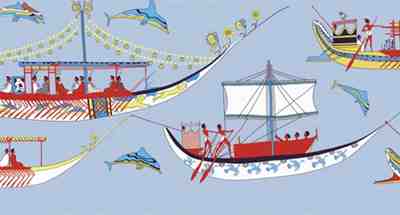
Minoan Miniature Frieze Admirals Flotilla Restoration Fresco
Shipping Scene
Late Bronze Age (LBA)
Neo-Palatial Late Minoan I Period
West House, Room 5, South Wall
Akrotiri, Santorini (Thera), Greece
Shipping Scene
Late Bronze Age (LBA)
Neo-Palatial Late Minoan I Period
West House, Room 5, South Wall
Akrotiri, Santorini (Thera), Greece
They were constructed by first chopping down a single tall Cypress tree and stripping off its branches. The log was then dragged to the shipyard by a team of oxen. After being laid on a smooth flat working surface, it was stripped of its bark. When the log was clean, the shipwright marked where he wanted it cut along its length. A team of men carved it with their sharp bronze axes and saws; shaping it to nearly its final form. The upward sloping curves of the bow and stern were bent into shape using heat and steam. After the keel attained its final shape, a long cleanly sawn plank of Cypress was 'edge-joined' to each side of it. They chiseled out deep rectangular matching slots (mortises) along the length of the keel and the length of one of the edges of the plank. Flat rectangular pieces of wood (tenons or tongues) were cut to fit snugly
into the matching slots. When the plank fit onto the tenons sticking out of the slots in the keel, the joins were filled with a mixture of resins.

Minoan Miniature Frieze Admirals Flotilla Restoration Fresco
Depiction of the Ringed Islands of Thera
Late Bronze Age (LBA)
Neo-Palatial Late Minoan I Period
West House, Room 5, South Wall
Akrotiri, Santorini (Thera), Greece
Depiction of the Ringed Islands of Thera
Late Bronze Age (LBA)
Neo-Palatial Late Minoan I Period
West House, Room 5, South Wall
Akrotiri, Santorini (Thera), Greece
Round holes were cut, using a bronze bow drill, through the plank and keel into the top and bottom of each tenon sitting inside the matching slots. After sealing resin was painted into the drill holes, round wooden pegs were hammered from the inside of the hull into the top and bottom holes of each tenon locking the plank to the keel. Very little caulking was needed with edge-joined planking. When the ship slid into the water from its dry dock, the sea water would swell the cypress and create a water tight seal on the seams.

Minoan Ship with Sail Only
Minoan Miniature Frieze Admirals Flotilla Fresco
Late Bronze Age (LBA)
Neo-Palatial Late Minoan I Period
The West House, Room 5, South Wall
Akrotiri, Santorini (Thera), Greece.
Minoan Miniature Frieze Admirals Flotilla Fresco
Late Bronze Age (LBA)
Neo-Palatial Late Minoan I Period
The West House, Room 5, South Wall
Akrotiri, Santorini (Thera), Greece.
With the first plank in place, they added the second plank by edge-joining it to the exposed edge of the first using the same process. The mortise slots were cut about every twenty five centimeters. They repeated this process adding plank after plank on both sides of the keel to build up the shell of the hull. Once the shell reached a desired height, the inner bracing frames were constructed, and later the decking and rowing benches were installed. When it was complete, the outside of the hull would be covered in tightly woven, treated linen, painted white, and decorated with beautiful scenes of the sea with blue dolphins, sea birds, etc.

Minoan Ship with Rowers Only
Minoan Miniature Frieze Admirals Flotilla Fresco
Late Bronze Age (LBA)
Neo-Palatial Late Minoan I Period
The West House, Room 5, South Wall
Akrotiri, Santorini (Thera), Greece.
Minoan Miniature Frieze Admirals Flotilla Fresco
Late Bronze Age (LBA)
Neo-Palatial Late Minoan I Period
The West House, Room 5, South Wall
Akrotiri, Santorini (Thera), Greece.
The sturdy oak mast was about sixteen meters tall and sat in a reinforced structure that allowed for its insertion and removal. It was secured into position with rigging made of strong hemp ropes. The mast had a single boom of about ten meters in length to hold the top of the sail. The center of the boom was held to the mast with a thick strong ring of rope loosely wrapped around the shaft of the mast. This allowed the boom to freely pivot about the mast in the wind and be easily raised or lowered with ropes running through a bronze fixture on the masthead. The orientation of the boom and sail in the wind could be controlled from the deck with ropes allowing the ship to tack (take a zigzag course) quite well into a head wind. The sail itself was made entirely of densely woven wool; treated with oils for waterproofing. The oars were carved from oak.
- Excerpt - "The Minoan Psychopath"
Bibliography:
Pulak,Cemal and Bass, George F. "Bronze Age Shipwreck Excavation at Uluburun". Institute of Nautical Archaeology.
Pulak,Cemal and Bass, George F. "Bronze Age Shipwreck Excavation at Uluburun". Institute of Nautical Archaeology.
Modern boat builders have learned a lot from the ancient Minoan ships and the shape of their hulls. Power Catamarans For Sale also used a flared bow to help with steering in rough seas.
2007
W. Sheppard Baird
Copyright © 2007, 2024 W. Sheppard Baird
All Rights Reserved
All Rights Reserved
-

Minoan Ship with Rowers Only
Akrotiri, Santorini (Thera), Greece
-

Minoan Ship with Sail Only
Akrotiri, Santorini (Thera), Greece
-

Minoan Miniature Frieze
Admirals Flotilla Fresco
Shipping Scene Restoration
West House, Room 5, South Wall
Akrotiri, Santorini (Thera), Greece
-

Mediterranean Sea
-

Minoan Dolphins Restoration Fresco
Knossos, Crete, Greece
-
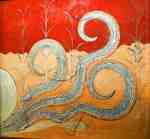
Minoan Octopus Fresco
Knossos, Crete, Greece
-

Volcanic Ash Cast of Wooden Table
Akrotiri, Santorini (Thera), Greece
-
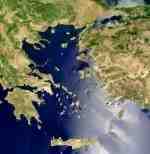
Aegean Sea
-
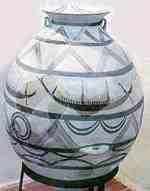
Aegean Vase with Ship Figures
1700BC
-
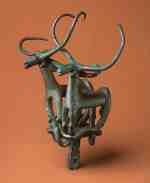
Arsenical Copper Bulls
Standard with Two Long-Horned Bulls
2400 - 2000 BC
Early Bronze Age III
North Central Anatolia
-
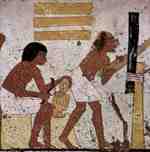
Egyptian Depiction of Bronze Saw
Egypt, 1350 BC
-
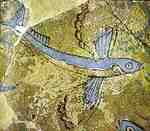
Minoan Flying Fish Fresco
Phylakopi, Milos, Greece
-
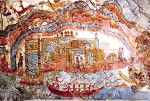
Minoan Miniature Frieze
Admirals Flotilla Fresco
Thera Scene
West House, Room 5, South Wall
Akrotiri, Santorini (Thera), Greece